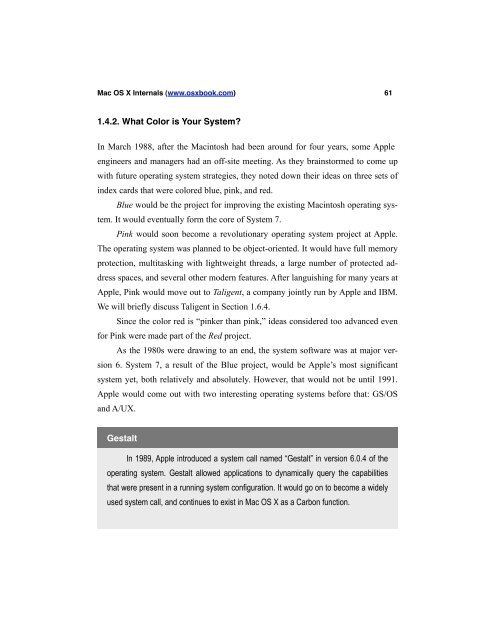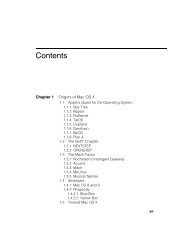A Technical History of Apple's Operating Systems - Mac OS X Internals
A Technical History of Apple's Operating Systems - Mac OS X Internals
A Technical History of Apple's Operating Systems - Mac OS X Internals
Create successful ePaper yourself
Turn your PDF publications into a flip-book with our unique Google optimized e-Paper software.
<strong>Mac</strong> <strong>OS</strong> X <strong>Internals</strong> (www.osxbook.com) 61<br />
1.4.2. What Color is Your System?<br />
In March 1988, after the <strong>Mac</strong>intosh had been around for four years, some Apple<br />
engineers and managers had an <strong>of</strong>f-site meeting. As they brainstormed to come up<br />
with future operating system strategies, they noted down their ideas on three sets <strong>of</strong><br />
index cards that were colored blue, pink, and red.<br />
Blue would be the project for improving the existing <strong>Mac</strong>intosh operating sys-<br />
tem. It would eventually form the core <strong>of</strong> System 7.<br />
Pink would soon become a revolutionary operating system project at Apple.<br />
The operating system was planned to be object-oriented. It would have full memory<br />
protection, multitasking with lightweight threads, a large number <strong>of</strong> protected ad-<br />
dress spaces, and several other modern features. After languishing for many years at<br />
Apple, Pink would move out to Taligent, a company jointly run by Apple and IBM.<br />
We will briefly discuss Taligent in Section 1.6.4.<br />
Since the color red is “pinker than pink,” ideas considered too advanced even<br />
for Pink were made part <strong>of</strong> the Red project.<br />
As the 1980s were drawing to an end, the system s<strong>of</strong>tware was at major ver-<br />
sion 6. System 7, a result <strong>of</strong> the Blue project, would be Apple’s most significant<br />
system yet, both relatively and absolutely. However, that would not be until 1991.<br />
Apple would come out with two interesting operating systems before that: GS/<strong>OS</strong><br />
and A/UX.<br />
Gestalt<br />
In 1989, Apple introduced a system call named “Gestalt” in version 6.0.4 <strong>of</strong> the<br />
operating system. Gestalt allowed applications to dynamically query the capabilities<br />
that were present in a running system configuration. It would go on to become a widely<br />
used system call, and continues to exist in <strong>Mac</strong> <strong>OS</strong> X as a Carbon function.




